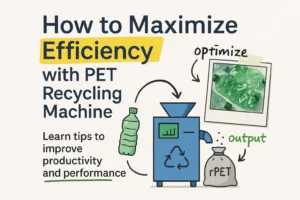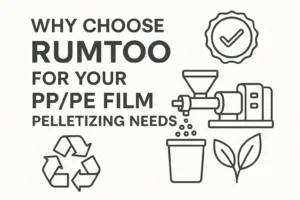Introduction to PET Plastic Recycling
Polyethylene Terephthalate (PET) is one of the most widely used plastics, especially for beverage and food packaging. With the growing demand for sustainability, recycling PET plastic bottles has become increasingly important. Recycling PET not only reduces environmental pollution but also helps conserve natural resources and supports a circular economy.
In this article, we’ll explore the recycling process and the various methods used to recycle PET plastic bottles, focusing on both physical and chemical methods. We’ll also discuss the benefits of PET recycling and how advanced technologies can improve the efficiency of the process.
The PET Recycling Process: A Step-by-Step Guide
Recycling PET involves several crucial steps to ensure that the material is cleaned, purified, and transformed into high-quality recycled PET (rPET) that can be used in new products. The following are the common steps involved in the PET bottle recycling process:
1. Collection and Sorting
The first step in the PET recycling process is collecting used PET bottles. Once collected, the bottles are sorted to separate them from other materials, such as non-PET plastics, metals, and organic waste. This sorting process is vital to ensure that only pure PET is processed, as contamination can affect the quality of the recycled material.
2. Shredding
After sorting, the PET bottles are shredded into smaller pieces, commonly referred to as PET flakes. The shredding process makes it easier to clean and process the PET, and it also increases the surface area for the subsequent washing stages.
3. Washing and Cleaning
The shredded PET flakes are washed to remove impurities such as labels, adhesives, dirt, and other contaminants. This is a critical step to ensure the production of high-quality rPET. Different cleaning methods can be used, including water flotation, hydrocyclone separation, and detergent solutions, to effectively separate contaminants from the PET flakes.
4. Separation of Impurities
Advanced separation technologies play a crucial role in ensuring the purity of the recycled PET. Some of the impurities, such as labels, aluminum caps, and adhesives, are removed using techniques like air classifiers, flotation tanks, and electrostatic separators. These methods rely on differences in material density and static charge to separate PET from contaminants.
5. Drying and Crystallization (Optional)
In some recycling processes, the PET flakes are dried and crystallized to prepare them for extrusion. However, advanced recycling technologies, like those offered by Rumtoo, have eliminated the need for this step, making the process more energy-efficient and cost-effective.
6. Extrusion and Pelletizing
The cleaned and dried PET flakes are then melted and extruded into long strands. These strands are cooled and cut into small pellets, which can be used as raw material for producing new PET products. The extruder used in this step ensures that the PET material is evenly melted and homogenized, removing any residual impurities.
Methods of PET Recycling: Physical vs. Chemical
There are two primary methods used to recycle PET plastic bottles: physical recycling and chemical recycling. Each method has its advantages and applications depending on the desired outcome.
Physical Recycling Methods
Physical recycling involves the mechanical processing of PET plastic to convert it into new products. The main physical methods include:
- Shredding and Sorting: PET bottles are shredded into flakes, and impurities such as HDPE (high-density polyethylene), aluminum, paper, and adhesive residues are removed.
- Washing and Pelletizing: The PET flakes are cleaned and then converted into pellets, which are used in the manufacturing of new PET products.
- Mechanical Separation: Physical methods also involve the use of mechanical techniques such as flotation and air classifiers to separate PET from other materials based on their density.
Physical recycling is typically the simplest and most widely used method, but it is not always suitable for processing highly contaminated PET bottles or achieving food-grade quality rPET.
Chemical Recycling Methods
Chemical recycling, also known as advanced recycling, involves breaking down PET into its basic chemical components so that it can be re-synthesized into new PET plastic. The main chemical recycling methods include:
- Hydrolysis: PET is treated with water and heat to break down the polymer into its monomers, which can then be purified and used to produce new PET.
- Alcoholysis: In this process, PET is reacted with alcohols to produce monomers that can be used to create new PET.
- Ammonolysis and Aminolysis: These processes use ammonia or amines to break down PET into its constituent monomers, which can be recycled into new PET material.
- Thermal Cracking: PET is subjected to high temperatures to break it down into lower-molecular-weight compounds, which can be used to produce new plastic.
Chemical recycling methods are more complex and costly than physical recycling, but they offer the advantage of being able to handle PET with higher levels of contamination and produce high-quality, food-grade recycled PET.
Environmental and Economic Benefits of PET Recycling
Recycling PET offers significant environmental benefits, including:
- Reduced Landfill Waste: PET recycling reduces the amount of plastic waste that ends up in landfills or the environment.
- Conservation of Resources: By recycling PET, we reduce the need for virgin materials, conserving natural resources like petroleum.
- Lower Energy Consumption: Modern recycling technologies, such as those developed by Rumtoo, require less energy than traditional methods, leading to a reduction in carbon emissions.
- Economic Gains: PET recycling is an economically viable process, creating new business opportunities and reducing the cost of raw materials.
By adopting PET recycling, businesses can not only improve their environmental footprint but also reduce operational costs and enhance profitability through the sale of recycled PET products.
Conclusion
The recycling process of PET plastic bottles is an essential part of creating a sustainable and circular economy. With the use of advanced physical and chemical recycling technologies, businesses can ensure high-quality recycled PET while reducing energy consumption, contamination, and environmental impact. Whether through mechanical methods like shredding and washing or more advanced chemical processes, PET recycling plays a critical role in protecting the environment and promoting sustainable practices in the plastic industry.
At Rumtoo, we specialize in providing cutting-edge PET recycling machines that streamline the entire process, offering high efficiency and exceptional product quality. If you are looking to enhance your PET recycling capabilities, contact us today to learn how our technology can benefit your business.


